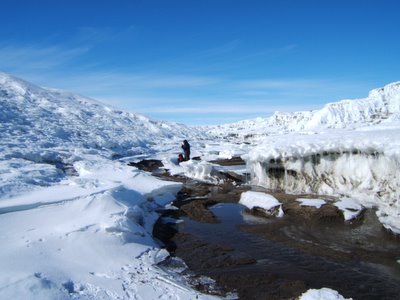 Most of the mass loss of glaciers in the polar desert is due to sublimation, not melt. The ice disappears immediately into the parched air. But, during the austral summer (now), with 24 hours of sunlight and near freezing temperatures, the sun heats up the debris on the glaciers--- in the same way that asphalt gets hotter than the neighboring sidewalk. During this season, there is melt. Much of the melt occurs along the margins of the glacier, where windblown soil collects, and where the sun has better access to the surface (the sun circles around the horizon, rather than rising and setting above our
Most of the mass loss of glaciers in the polar desert is due to sublimation, not melt. The ice disappears immediately into the parched air. But, during the austral summer (now), with 24 hours of sunlight and near freezing temperatures, the sun heats up the debris on the glaciers--- in the same way that asphalt gets hotter than the neighboring sidewalk. During this season, there is melt. Much of the melt occurs along the margins of the glacier, where windblown soil collects, and where the sun has better access to the surface (the sun circles around the horizon, rather than rising and setting above our  heads).
heads).Yesterday, Liz Miller (from OSU) and I sampled along the margin of the Canada Glacier, where a huge waterfall gushed. This entailed wearing the white sampling suit and getting soaked from the spray. (Fortunately, polypro clothing is still warm when it is wet, and our camp was just a half hour from the sampling site). That was probably for the best, as it has been almost a week since my last shower.
Today, I head up with Hassan and Liz Bagshaw and Rae to readjust the upper met station on the Canada Glaicer and take more samples of water flowing on the glacier surface (supraglacial streams). We will wear the white outfits, to avoid putting any metal that we have on our bodies and clothes into the samples... it is amazing how much lead, copper, cadmium is in everyday packaging, lotions, and utensils. Cosmetics are the worst- fortunately, there is no need for makeup here--- with the exception of an occasional costume party. (Pictured below are organisms observed in a Canada Glacier supraglacial channel that may be utilizing metals as nutrients).--- The channel is approximately 1.5 meters deep and .3 meters wide.

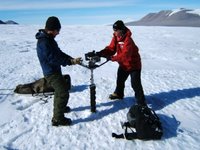 Liz will also be collecting samples for nutrients in the cryoconite holes (melt holes with ice lids- that trap dust and micro-organisms). She cuts them out with a Sipre ice corer--- that is revved up by pulling a cord much like a lawn mower--- and equally noisy. How did these organisms get on the glacier surface? Were they blown from the soil? Did they come from the seaspray of the Ross Sea? Did they migrate up the glacier? (Most likely they were blown from somewhere given their prevalence on dirtier glaciers at lower elevations.
Liz will also be collecting samples for nutrients in the cryoconite holes (melt holes with ice lids- that trap dust and micro-organisms). She cuts them out with a Sipre ice corer--- that is revved up by pulling a cord much like a lawn mower--- and equally noisy. How did these organisms get on the glacier surface? Were they blown from the soil? Did they come from the seaspray of the Ross Sea? Did they migrate up the glacier? (Most likely they were blown from somewhere given their prevalence on dirtier glaciers at lower elevations. Earlier, Liz chain-sawed a piece of the basal (glacier bottom) ice out to look for nutrients.... as scientist have already found evidence of primative organisms living at the basal interface between glacier and soil/rock. Often, these organisms freeze during the winter and come to life during any year that there is sufficient melt. They feed on the nutrients from the dissolved rocks. They are in every way extremophils. After today, Berry and I will sample the Canada Stream on the east side of the Canada Glacier--- this side has many algal matts, in contrast to the west side stream I have already sampled. I may be able to determine by sampling above and below the matts if trace metals are acting as nutrients (food) for the matts. We will also look at the waterfalls, I could use another shower.
Earlier, Liz chain-sawed a piece of the basal (glacier bottom) ice out to look for nutrients.... as scientist have already found evidence of primative organisms living at the basal interface between glacier and soil/rock. Often, these organisms freeze during the winter and come to life during any year that there is sufficient melt. They feed on the nutrients from the dissolved rocks. They are in every way extremophils. After today, Berry and I will sample the Canada Stream on the east side of the Canada Glacier--- this side has many algal matts, in contrast to the west side stream I have already sampled. I may be able to determine by sampling above and below the matts if trace metals are acting as nutrients (food) for the matts. We will also look at the waterfalls, I could use another shower.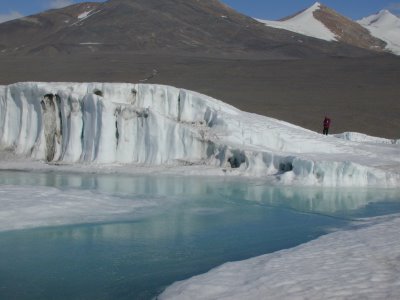
This year is far less wet than the extreme (10 to 20 year event) melt year of 2001-2002 when I did my Master's degree--- pictured above. During the 01-02 season the melt losses of the lakes over the last 2 decades were refilled with flooding glacier waters--- Lake Hoare pictured below had huge moats. (you can see camp in the far right)
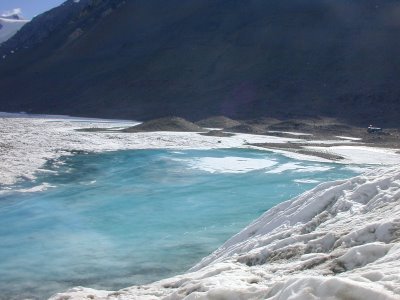
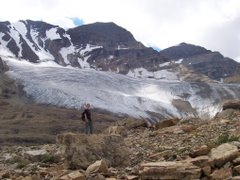
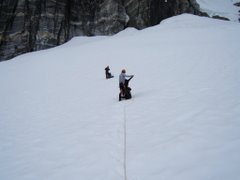

1 comment:
I'm loving all the pictures and beautiful writing! By the way, let ALL those men with spouses know that I can mail their wife a beautifully-wrapped Spa gift if they want to be remembered while they are gone--especially if they'll be gone for Valentine's Day.
Post a Comment